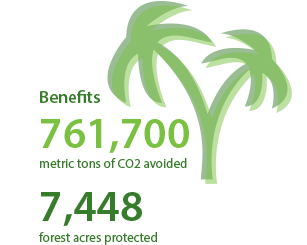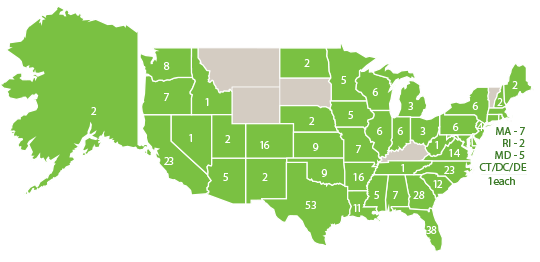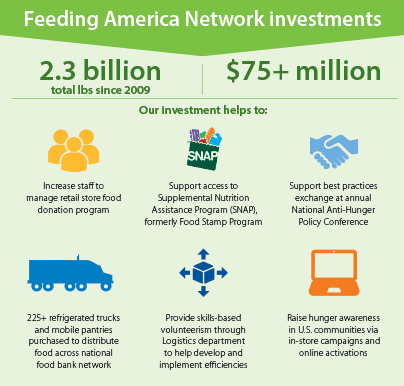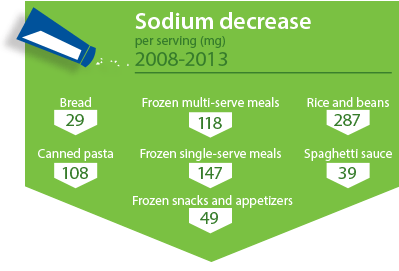
Increase food safety and transparency
As we expand our food sales across our retail markets, our goal is to bring affordable food to our customers while continually raising the bar on food safety. In addition, customers are increasingly interested in understanding where their food comes from, what’s in it and how it’s made. GMOs, antibiotics, animal welfare and farm labor within the food supply chain are more than buzzwords. They’re critical issues that play into our ability to influence a sustainable future for people and the planet. We’re working to increase food safety and transparency by:
- Collaborating within the supply chain
- Communicating policies and standards
- Creating accountability through metrics
- Establishing consistency within global requirements and audit protocol
GFSI certification journey
Prior to 2000, the industry lacked a way to ensure all food safety audits contained the same core requirements, which resulted in inconsistencies and inefficiencies around the world. The food industry took a significant step forward with the creation of the Global Food Safety Initiative (GFSI) — a collaboration of the world’s leading food safety experts from retail, manufacturing and food service companies, as well as international organizations, governments, academia and service providers — to gain alignment and credibility.
Companies can now move forward with confidence, knowing GFSI certification included a consistent set of global requirements and an audit protocol. In 2008, Walmart became the first U.S. grocer to require all private-brand suppliers and select categories of national brand suppliers to be certified against one of the GFSI-recognized schemes. In 2010, we expanded our commitment to align all private-brand suppliers and company-owned food production facilities in our international markets with GFSI. This commitment continues to be our driving force, oftentimes raising our food safety standards even higher than those required in the individual markets we serve.
U.S.
- In 2014 alone, nearly 900 private-brand suppliers and Walmart-owned food production facilities earned GFSI certification.
- Since the initial rollout in 2008, more than 4,000 such facilities providing products to Walmart U.S. and Sam’s Club U.S. have achieved certification.
International
- When our international GFSI journey began in 2010, none of our company-owned facilities were certified. Of our certified private-brand suppliers, more than 93 percent was located in the U.K.
- The number of international private-brand suppliers certified against a GFSI standard more than doubled between 2010 and 2014, from about 1,000 in February 2010 to nearly 2,100 in December 2014.
- More than half of all company-owned manufacturing facilities are now GFSI-certified, and the remaining locations are on track to earn certification in the next few years.
MWD Farms: ‘Stair stepping’ for small and developing suppliers
Recognizing that small and developing suppliers don’t always have the expertise, capacity or financial resources to follow the traditional route to GFSI certification, Walmart created a Global Markets Program in 2011. By working directly with these suppliers, we offer a stair-step approach toward certification. To date, Walmart U.S. has helped develop more than 150 suppliers using this program.
Dave Sargent, owner of MDW Farms in Arkansas, is one of those suppliers. Dave began farming a one-quarter acre plot in 2001, supplying one Walmart store with a single produce item. Over the years, he’s grown his operation to more than 1,400 acres, supplying bell peppers, cucumbers, green beans, okra and squash to Walmart distribution centers in Arkansas, Mississippi, Oklahoma and Texas. Dave enrolled in the Global Markets Program in 2011, stair-stepping MDW Farms to a GFSI-recognized certification by August 2013.
Leading in poultry safety

According to the Centers for Disease Control and Prevention (CDC), 19 percent of foodborne illness deaths are linked to poultry, and more than 25 percent of those are directly tied to Salmonella. While the industry has significantly reduced the risk of Salmonella contamination on whole chickens, the contamination rate in the U.S. increases as chicken is further processed into parts.
In December 2014, Walmart took a leadership role by implementing enhanced poultry safety measures for suppliers designed to further protect customers against foodborne illnesses. The new guidelines — created in collaboration with CDC — are in addition to our food safety program that requires poultry suppliers to achieve prevention-based certification against one of the Global Food Safety Initiative (GFSI) internationally recognized standards. According to CDC, these additional requirements represent a significant step toward reducing cases of Salmonella by 2020.
The new program requires Walmart and Sam’s Club U.S. poultry suppliers to implement holistic controls from farm to fork designed to significantly reduce potential contamination levels, including chicken parts. It also requires suppliers to undergo specialized testing to validate that the measures they have implemented are effective. Several stakeholder groups, including regulators, academicians and poultry industry associations, reviewed protocol, and all suppliers must be in compliance by June 2016.
CDC, along with Walmart, recognizes that reducing Salmonella and other pathogen contamination in poultry products is a crucial step toward decreasing the burden of foodborne illnesses. Walmart and CDC working together to protect public health and advance food safety is a great example of a public—private partnership that benefits everyone.
Dr. Chris Braden, director, Centers for Disease Control
and Prevention, Division of Foodborne, Waterborne
and Environmental Diseases
Challenges: Food safety and transparency
The food system is very global, and products are often moved several times before they reach our customers. In many cases, we’re several tiers removed from the site of original production, and it’s not common industry practice to have traceability of ingredients throughout the supply chain. So much of what we’re aspiring to — and the level of transparency our customers want — isn’t required by law in most countries. So we’re asking the supply chain to go above and beyond for the customer. We’re experimenting with ways to increase direct relationships and to increase information sharing and traceability in categories, such as dry grocery.
Measurement and access to information
Aspiration
Use the Sustainability Index to track sustainability improvements in food supply, and for 70 percent of goods sold in Walmart U.S. stores, if those goods are covered by the Index.
We use the Index to measure and advance continuous improvement across the world’s largest assortment of food. It enables us to work hot-spot issues in various food categories, such as pesticides, water, labor or fertilizer. Our buyers use it to work with suppliers to agree on improvement opportunities. In 2014, nearly 60 percent of food sales in the U.S. were tracked by the Sustainability Index.
HarvestMark Traceability

Sam’s Club is committed to bringing more transparency to the member shopping experience through a produce QR code program in collaboration with HarvestMark. Once live in clubs, members will be able to scan the QR codes and instantly connect to more information about products, such as where they are grown, nutrition facts, selection tips and recipes. Members will also be able to submit feedback about their experience with the products through the HarvestMark platform, providing valuable insight that will help Sam’s Club optimize freshness and quality.
In January 2014, Sam’s Club began designing the program and collaborating with suppliers. By the end of the year, 137 suppliers had signed on with HarvestMark and began developing their QR codes. The program is expected to launch in clubs in 2015.
U.K. video image analysis project
Many national beef carcass-grading schemes are based on visual assessment against country-specific grids. These, while described as market-related, don’t accurately reflect the retail value of the carcass. Our Asda business in the U.K. has collaborated with ABP Food Group to introduce Video Image Analysis to provide farmers with information that helps determine payment for strip loin or fillet without having to physically butcher the carcass. We’ve implemented the system in Perth and, in the coming years, plan to roll it out across factories that supply Asda with beef.
U.S. pork monitoring
We hold our suppliers to high standards and do not tolerate animal mistreatment. We recently began the rollout of a comprehensive auditing and tracking program for pork that includes the installation of video monitoring in U.S. barns. This will help ensure that we purchase only from farms that meet the standards of the National Pork Board’s Pork Quality Assurance Plus Program.
Challenges:
The food system is very global, and products are often moved several times before they reach our customers. In many cases, we’re several tiers removed from the site of original production, and it’s not common industry practice to have traceability of ingredients throughout the supply chain. So much of what we’re aspiring to — and the level of transparency our customers want — isn’t required by law in most countries. So we’re asking the supply chain to go above and beyond for the customer. We’re experimenting with ways to increase direct relationships and to increase information sharing and traceability in categories, such as dry grocery.


















